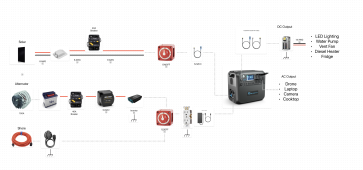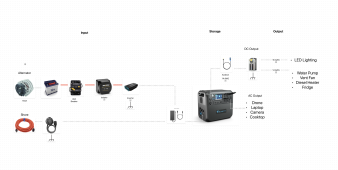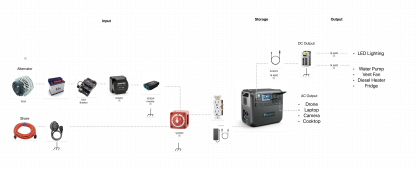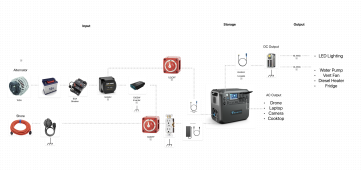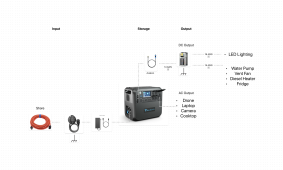StellarOverland
New Member
Hello all,
I am using a Bluetti AC200Max as the heart of my van build electrical. The idea was to simplify the build so that I could get on the road sooner. The unit has all the power that I "need", but as its not designed for this application I am running into some limitations.
Surprisingly I haven't found much guidance on a semi permanent install of a solar generator in a van. What I have found, I don't like.
The simplest way to use this equipment is to charge it with an extension cord to my house before a trip (perhaps with a shore power receptacle to make the connection more tidy). But that isn't practical. I need to be able to charge it at an acceptable rate, and distribute power without plugging in extension cords.
Distributing DC power for the the fan, ceiling lights, and diesel heater necessitates connecting a DC Subpanel to the 30A DC Output (aviation plug). Easy enough.
Distributing AC Power could just be done with the outlets on the unit, however the unit will be on the left side of the van, and the galley on the right.
Additionally, I am designing this system so that in the future I could replace it with a different unit, different brand, or a full Victron/Renogy system.
So, I would rather distribute the AC power from an otherwise unused outlet on the unit and keep the rest of them open for random item use.
Charging the unit at an acceptable rate also requires me to build out more system. The unit comes supplied with a cigarette charging cord but for obvious reasons this is less than ideal (slow). The unit is capable of "dual charging" using its AC In (8A AC/Wall Charger) and DC In (aviation plug, 15A) in ports.
The only way that I can see to utilize this while driving is to use the DC in port for solar and the AC In port for alternator via a inverter.
I mocked up a diagram.
I am confused about Grounding.
I have some reading to do about electrical theory for sure, because I don't understand "phases", neutral, and grounding. That said, I am hoping someone can help me for now so that I can continue working on the build. The unit itself is meant to be used indoors without grounding. Sort of like a battery pack for your phone. But, I am building an electrical system around it for charging and distribution. So that system needs to be grounded.
I have grounded the Inverter, Shore Power, the DC distribution box, and the outlet that connects the shore power or Inverter to the unit.
Is that enough?
The diagram isnt fully labeled, and I used grey dashed lines to denote a connection without specifying wire size
I also am questioning my approach. The idea of using this item was to simplify the build and reduce cost. I got this unit as refurbrished for about 1350$ but it arrived inoperative. I had to return it and the customer service experience was .... alarming. The advantage of a unit like this is to be able to plug and play, but the limitations and desire for usability (charging and distribution) + the concerns about relability and customer service has me thinking that I should just built a basic system from components. Anyway, for now I am pressing onwards. I am still awaiting a confirmation email from Bluetti for my extended 4 year warranty.
I am using a Bluetti AC200Max as the heart of my van build electrical. The idea was to simplify the build so that I could get on the road sooner. The unit has all the power that I "need", but as its not designed for this application I am running into some limitations.
Surprisingly I haven't found much guidance on a semi permanent install of a solar generator in a van. What I have found, I don't like.
The simplest way to use this equipment is to charge it with an extension cord to my house before a trip (perhaps with a shore power receptacle to make the connection more tidy). But that isn't practical. I need to be able to charge it at an acceptable rate, and distribute power without plugging in extension cords.
Distributing DC power for the the fan, ceiling lights, and diesel heater necessitates connecting a DC Subpanel to the 30A DC Output (aviation plug). Easy enough.
Distributing AC Power could just be done with the outlets on the unit, however the unit will be on the left side of the van, and the galley on the right.
Additionally, I am designing this system so that in the future I could replace it with a different unit, different brand, or a full Victron/Renogy system.
So, I would rather distribute the AC power from an otherwise unused outlet on the unit and keep the rest of them open for random item use.
Charging the unit at an acceptable rate also requires me to build out more system. The unit comes supplied with a cigarette charging cord but for obvious reasons this is less than ideal (slow). The unit is capable of "dual charging" using its AC In (8A AC/Wall Charger) and DC In (aviation plug, 15A) in ports.
The only way that I can see to utilize this while driving is to use the DC in port for solar and the AC In port for alternator via a inverter.
I mocked up a diagram.
I am confused about Grounding.
I have some reading to do about electrical theory for sure, because I don't understand "phases", neutral, and grounding. That said, I am hoping someone can help me for now so that I can continue working on the build. The unit itself is meant to be used indoors without grounding. Sort of like a battery pack for your phone. But, I am building an electrical system around it for charging and distribution. So that system needs to be grounded.
I have grounded the Inverter, Shore Power, the DC distribution box, and the outlet that connects the shore power or Inverter to the unit.
Is that enough?
The diagram isnt fully labeled, and I used grey dashed lines to denote a connection without specifying wire size
I also am questioning my approach. The idea of using this item was to simplify the build and reduce cost. I got this unit as refurbrished for about 1350$ but it arrived inoperative. I had to return it and the customer service experience was .... alarming. The advantage of a unit like this is to be able to plug and play, but the limitations and desire for usability (charging and distribution) + the concerns about relability and customer service has me thinking that I should just built a basic system from components. Anyway, for now I am pressing onwards. I am still awaiting a confirmation email from Bluetti for my extended 4 year warranty.
Attachments
Last edited:



